9(k) Characteristics of the Earth's Terrestrial Biomes (original) (raw)
Introduction
Many places on Earth share similar climatic conditions despite being found in geographically different areas. As a result of natural selection, comparable ecosystems have developed in these separated areas. Scientists call these major ecosystem types biomes. The geographical distribution (and productivity) of the various biomes is controlled primarily by the climatic variables precipitation and temperature. The map in Figure 9k-1 describes the geographical locations of the eight major biomes of the world. Because of its scale, this map ignores the many community variations that are present within each biome category.
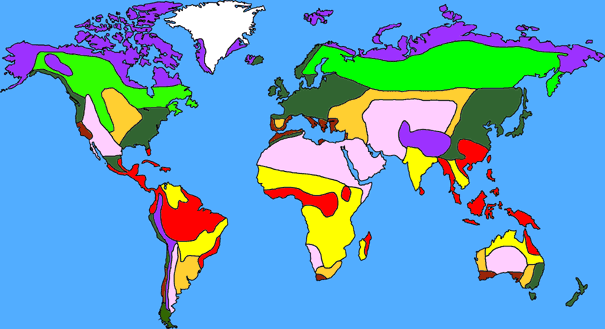
Figure 9k-1: Distribution of the Earth's eight major terrestrial biomes. Legend is below. (Adapted from: H.J. de Blij and P.O. Miller. 1996. Physical Geography of the Global Environment. John Wiley, New York. Pp. 290.)

Most of the classified biomes are identified by the dominant plants found in their communities. For example, grasslands are dominated by a variety of annual and perennial species of grass, while deserts are occupied by plant species that require very little water for survival or by plants that have specific adaptations to conserve or acquire water.
The diversity of animal life and subdominant plant forms characteristic of each biome is generally controlled by abiotic environmental conditions and the productivity of the dominant vegetation. In general, species diversity becomes higher with increases in net primary productivity, moisture availability, and temperature.
Adaptation and niche specialization are nicely demonstrated in the biome concept. Organisms that fill similar niches in geographically separated but similar ecosystems usually are different species that have undergone similar adaptation independently, in response to similar environmental pressures. The vegetation of California, Chile, South Africa, South Australia, Southern Italy and Greece display similar morphological and physiological characteristics because of convergent evolution. In these areas, the vegetation consists of drought-resistant, hard-leaved, low growing woody shrubs and trees like eucalyptus, olive, juniper, and mimosa.
Arctic and Alpine Tundra
Tundra means marshy plain. The geographical distribution of the tundra biome is largely poleward of 60° North latitude. The tundra biome is characterized by an absence of trees, the presence of dwarf plants, and a ground surface that is wet, spongy, and hummocky. Soils of this biome are usually permanently frozen (permafrost) starting at a depth of a few centimeters to meter or more. The permafrost line is a physical barrier to plant root growth.
Within this biome, temperature, precipitation, and evaporation all tend to be at a minimum. Most tundra locations, have summer months with an average temperature below 10° Celsius. Precipitation in the wettest month is normally no higher that 25 millimeters. However, despite the low levels of precipitation the ground surface of the tundra biome is often waterlogged because of low rates of evapotranspiration.
The species diversity of tundra vegetation is relatively small. Plant communities are usually composed of a few species of dwarf shrubs, a few grass species, sedges, and mosses. Perhaps the most characteristic arctic tundra plants are lichens like Reindeer Moss (Cladonia spp.). The principal herbivores in this biome include caribou, musk ox, arctic hare, voles, and lemmings. Most of the bird species of the tundra have the ability to migrate and live in warmer locations during the cold winter months. The herbivore species support a small number of carnivore species like the arctic fox, snow owl, polar bear, and wolves. Reptiles and amphibians are few or completely absent because of the extremely cold temperatures.
Alpine tundra is quite similar to some arctic tundra but differs in the absence of permafrost and in the presence of better drainage.
Boreal Coniferous Forest
This moist-cool, transcontinental coniferous forest, or taiga lies largely between the 45th and 57th North latitudes. The climate of this biome is cool to cold with more precipitation than the tundra, occurring mainly in the summer because of mid-latitude cyclones. The predominant vegetation of boreal biome are needle-leaf evergreen variety tree species. Some common species include: White Spruce (Picea glauca) and Balsam Fir (Abies balsamea) east of the Rockies; Red Pine (Pinus resinosa), White Pine (Pinus strobus), and Hemlock (Tsuga canadensis) in the Great Lakes Region. In British Columbia, dominant boreal trees include: Black Spruce (Picea mariana), White Spruce (Picea glauca), Lodgepole Pine (Pinus contorta), Ponderosa Pine (Pinus pondersoa), Douglas Fir (Pseudotsuga menziesii), and Alpine Fir (Abies lasiocarpa). The understory is relatively limited as a result of the low light penetration even during the spring and fall months. Understory plants in the deciduous biome take advantage of the leafless condition of trees during these seasons concentrating there growth during this time period. Common understory species include orchids, shrubs like rose, blueberry, and cranberry (Figure 9k-2).
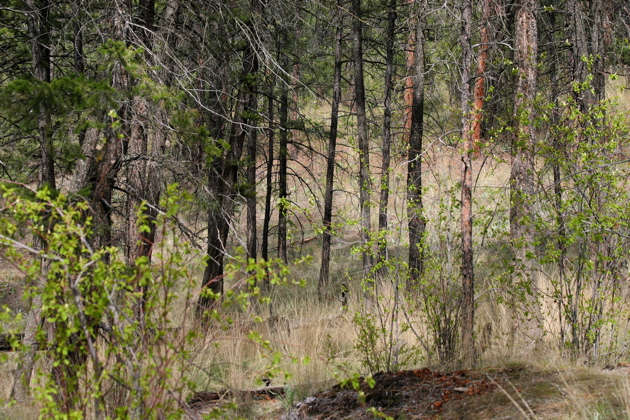
Figure 9k-2: The understory of boreal forest habitats is usually poorly developed.
Mammals common to the boreal forest include moose, bear, deer, wolverine, marten, lynx, wolf, snowshoe hare, vole, chipmunks, shrews, and bats (Figure 9k-3). Reptiles are rare, once again, because of cold temperatures .
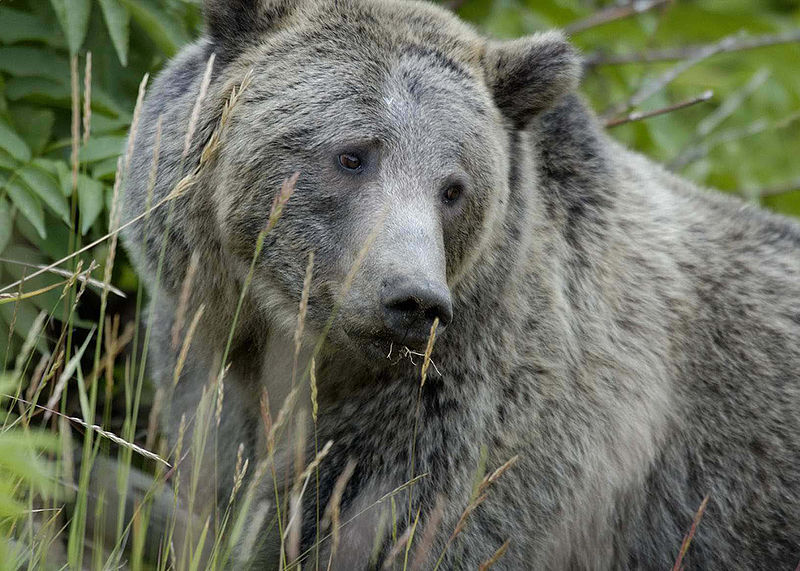
Figure 9k-3: Bears are common in the boreal forest ecosystem. (Source: Wikipedia).
Boreal forest soils are characterized by a deep litter layer and slow decomposition. Soils of this biome are also acidic and mineral deficient because of the large movement of water vertically though the profile and subsequent leaching.
Temperate Deciduous Forest
As its name indicates, this biome is characterized by a moderate climate and deciduous trees. It once occupied much of the eastern half of the United States, central Europe, Korea, and China. This biome has been very extensively affected by human activity, and much of it has been converted into agricultural fields or urban developments. Dominant plants include trees like Maple (Acer spp.), Beech (Fagus spp.), Oak (Quercus spp.), Hickory (Carya spp.), Basswood (Tilia spp.), Cottonwood (Populus spp.), Elm (Ulmus spp.), and Willow (Salix spp.). The understory of shrubs and herbs in a mature deciduous forest is typically well developed and richly diversified. Many different types of herbivores and carnivores, and some reptiles and amphibians exist here.
Brown forest soils characterize temperate deciduous forest ecosystems. The surface litter layer in these soils is thin due to rapid decomposition.
Grassland
In central North America are the grasslands, the tall grass prairie toward the east and the short grass prairie westward. In Europe and Asia some grasslands are called Steppes. In South America, grasslands are known as Pampas. Prior to modern man, the tall grass prairie was dominated by species of Bluestem (Andropogon spp.) (Figure 9k-4). This particular species dominated much of the tall grass prairie forming dense covers 1.5 to 2.0 meters tall. In the western end of the prairie, where precipitation is less, Buffalo Grass (Buchloe dactyloides) and other grasses only a few inches above the soil surface are common in this habitat. Flowering herbs, including many kinds of composites and legumes, are common but much less important than grass species. Trees are limited to low lying areas and the narrow zone immediately adjacent to streams.
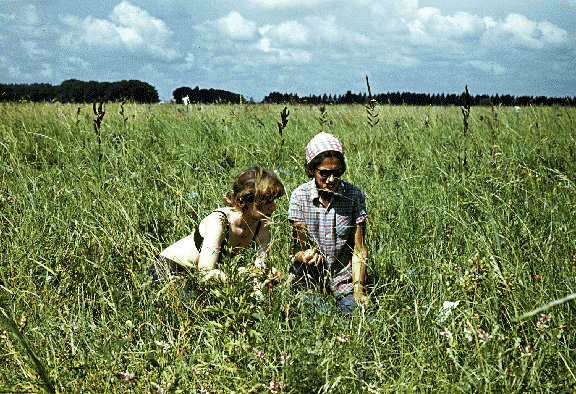
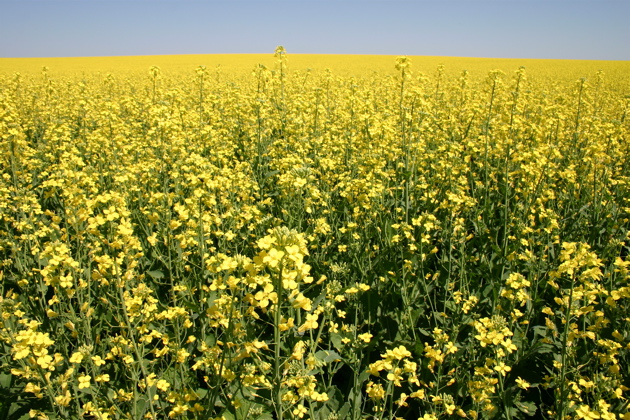
Figure 9k-5: Much of the prairies is now cultivated to grow crops like canola.
In the tall grass prairie organic rich and black chernozemic soils are common. Chernozems are among the richest in nutrients and consequently the most fertile in the world. In drier parts of prairies, soils can be influenced by salinization. As a result of their fertility, most grassland ecosystems have been modified by humans to grow grain and other dryland crops (Figure 9k-5).
Grassland mammals are dominated by smaller burrowing herbivores (prairie dogs, jack rabbits, ground squirrels, and gophers) and larger running herbivores such as bison, pronghorn antelope, and elk. Carnivores include badger, coyote, ferret, wolf, and cougar. The population size of many of these species has been drastically reduced because of habitat destruction (Figure 9k-5). Some of these species are on the edge of extinction.
Desert
In its most typical form, the desert consists of shrub covered land where the plants are spatially quite dispersed. In general, the major desert biomes of the Earth are geographically found at between 25 to 40° North and South latitude, in the interiors of continents. Climatically, deserts are influenced by descending air currents which limit the formation of precipitation. Many desert areas have less than 250 millimeters of precipitation annually. Dominant plants include drought resistant shrubs like the Creosote Bush (Larrea divaricata) and Sagebrush (Artemisia tridentata), water storing succulents like cactus (Figure 9k-6), and many species are short lived annuals that complete their life cycles during infrequent and short rainy periods. Desert habitats can be devoid of vegetation if precipitation is in very short supply (Figure 9k-7).
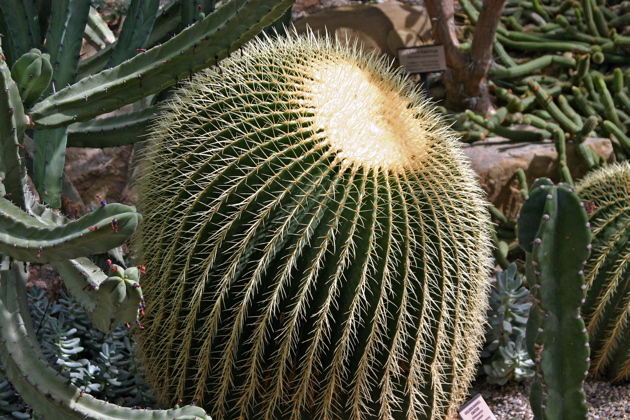
Figure 9k-6: Cactus are a common type of drought resistant plant found in deserts.
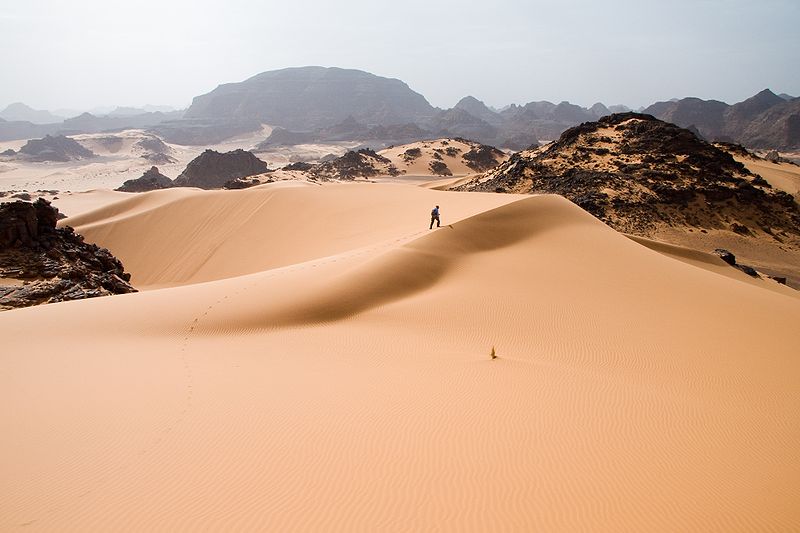
Figure 9k-7: Desert habitat devoid of vegetation. (Source: Wikipedia).
Most desert mammals tend to be nocturnal to avoid the high temperatures. Desert habitats have a rich lizard and snake fauna because high temperatures promote the success of cold blooded life forms (Figure 9k-8).
Figure 9k-8: Lizards are quite common in desert habitats. (Source: Wikipedia).
Because productivity is low, the litter layer is comparably limited and organic content of surface soil layers is very low. Also, evaporation tends to concentrate salts at the soil surface.
Chaparral
Chaparral has a very specific spatial distribution. It is found in a narrow zone between 32 and 40° latitude North and South on the west coasts of the continents. This area has a dry climate because of the dominance of the subtropical high pressure zone during the fall, summer, and spring months. Precipitation falls mainly in the winter months because of the seasonal movement of the polar front and its associated mid-latitude cyclone storms. Annual averages range from about 300 to 750 millimeters and most of this rain falls in a period between 2 to 4 months long. As a result of the climate, the vegetation that inhabits this biome exhibits a number of adaptations to withstand drought and fire. Trees and shrubs living in this zone tend to be small with hard evergreen leaves. Plants in the chaparral do not drop their leaves during the dry season because of the expense of replacement. The dry climate slows the rate of leaf decomposition in the soil. As a result, the plants growing in this biome do not have nutrients available for uptake to produce new leaves when the wet season begins. Instead, the plants of the chaparral develop leaves that can withstand arid conditions.
Representative species of the chaparral include cork oak (Quercus suber), olive (Olea europaea), eucalyptus, arbutus (Arbutus unedo), acacia, maritime pine (Pinus pinaster), shrub oak (Quercus dumosa), and live oak (Quercus agrifolia). Many of the plant species have thorns to protect them from herbivore damage.
This biome is sometimes also called Mediterranean Scrubland or sclerophyll forest.
Tropical Savanna
Tropical savannas are grasslands with scattered drought-resistant trees that generally do not exceed 10 meters in height (Figure 9k-9). Tree and shrub species in the savanna usually shed their leaves during the dry season. This adaptation reduces water loss from the plants. New leaves appear several weeks before the start of the rain season. Scientists believe that savanna plant species may have developed this strategy to take advantage of the season variance of the start of the rains. Climatically, these biomes are characterized by distinct wet and dry seasons. Temperatures are hot all year long.
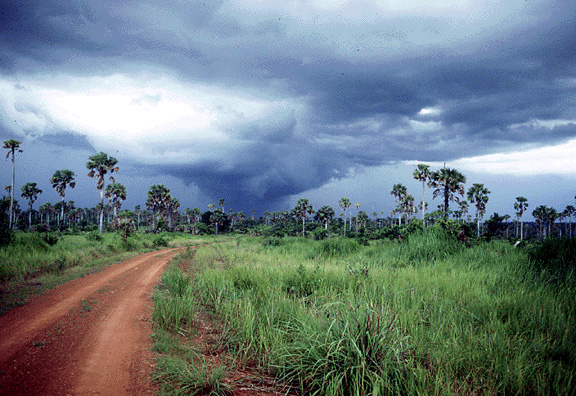
The savanna biome constitutes extensive areas in eastern Africa, South America, and Australia. Savannas also support the richest diversity of grazing mammals in the world (Figure 9k-10). The grazing animals provide food for a great variety of predators (Figure 9k-11).

Figure 9k-10: Giraffes are a common grazer on the African savanna.

Figure 9k-11: Savannas are also home to a number of predator species who prey on grazing animals.
The soils are more nutrient rich than tropical forest soils. Some soils become extremely dry because of evaporation and form laterite layers.
Tropical Rainforest
Tropical rainforests occur in a broad zone outside the equator. Annual rainfall, which exceeds 2000 to 2250 millimeters, is generally evenly distributed throughout the year. Temperature and humidity are relatively high through the year. Flora is highly diverse: a square kilometer may contain as many as 100 different tree species as compared to 3 or 4 in the temperate zone. The various trees of the tropical rain forests are closely spaced together and form a thick continuous canopy some 25 to 35 meters tall (Figure 9k-12). Every so often this canopy is interrupted by the presence of very tall trees (up to 40 meters) that have wide buttressed bases for support. Epiphytic orchids and bromeliads, as well as vines (lianas), are very characteristic of the tropical rainforest biome. Some other common plants include ferns and palms. Most plants are evergreen with large, dark green, leathery leaves.
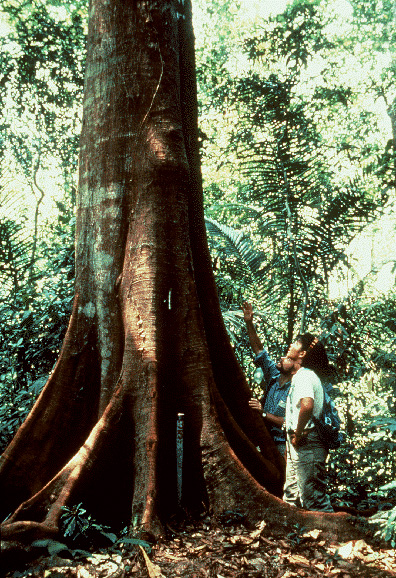
Figure 9k-12: Tropical trees often have buttressed bases to help support their heavy above-ground biomass. (Source:NASA - Oak Ridge National Laboratory (ORNL)Distributed Active Archive Center (DAAC) Net Primary Productivity (NPP) Database).
The tropical rainforest is also home to a great variety of animals (Figure 9k-13). Some scientists believe that 30 to 50% of all of the Earth's animal species may be found in this biome.
Figure 9k-13: The tropical rain forest is home to many different species of amphibians. (Source: Wikipedia).
Decomposition is rapid in the tropicals because high temperatures and an abundance of moisture. Because of the frequent and heavy rains, tropical soils are subject to extreme chemical weathering and leaching. These environmental conditions also make tropical soils acidic and nutrient poor.

